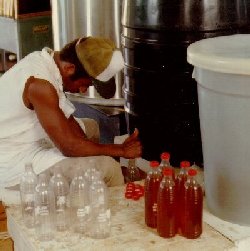John's Beekeeping Notebook
Experiences of a Peace Corps Beekeeper in Fiji
In the mid-1980's, I had an opportunity to serve in the Peace Corps doing rural development work in Fiji. My employer granted me a leave-of-absence. I sold my house and car in Houston, Texas, said goodbye to friends and began my service as a Peace Corps volunteer. Here are a few photos from my experiences.
Fijian beekeeping is described on this page, and Fijian culture on the following pages.
I was in Fiji for two years, mainly to provide beekeeping technical assistance to a village cooperative and farmers who were interested in beekeeping.
Beekeeping was viewed by the Fiji government as a potential source of rural income that did not require a big investment to get started. Fiji was a honey-importing country and the country's goal was to be self-sufficient in honey production.
An agricultural worker from New Zealand established some bee hives in the early 1980's and proved the area's potential for honey production. The U.S. Peace Corps was then asked to provide technical assistance.
The cooperative had two employees for me to work with on a honey project called "Saivou Honey." I also worked with several farmers and a shopkeeper who owned their own hives.
We worked entirely with deep hive bodies, since we were rapidly expanding our colony numbers. The hives were on concrete blocks to reduce losses from cane toads.
The wild bees on the island were the German "black" bee that were brought to the South Pacific by the early European visitors in the 1800's. They are a mean, nasty, bee! They were very defensive, ran on the comb, and the queens were hard to find.
We imported Italian queens and raised our own Italian-German bee crosses that were good producers, though a bit cranky at times.
A woman in the village made our veils from window screen wire and cloth. We made our hive tools from spring steel.
We made all of our woodenware except frames. A hand-held power saw mounted to the underside of a table became our table saw. We were fortunate to have a generator to provide electricity for the saw and our radial extractor.

We tried several methods of making wax foundation, but were not very successful. We imported frames and foundation.
Our honey house building and equipment was funded in part by a grant from the U.S. Agency for International Development (USAID).
In the photo at left, Sekove uncaps with a steam knife while Amani extracts and handles the supers.

Our honey was sold to local shops and also to supermarkets. The honey color ranged from medium to dark amber, and was a fair grade of table honey.
Some of the people that I worked with succeeded at beekeeping, while others failed. The hardest things to teach were regular colony maintenance, and the need to reinvest some money back into the business.
More on Fiji . . . .